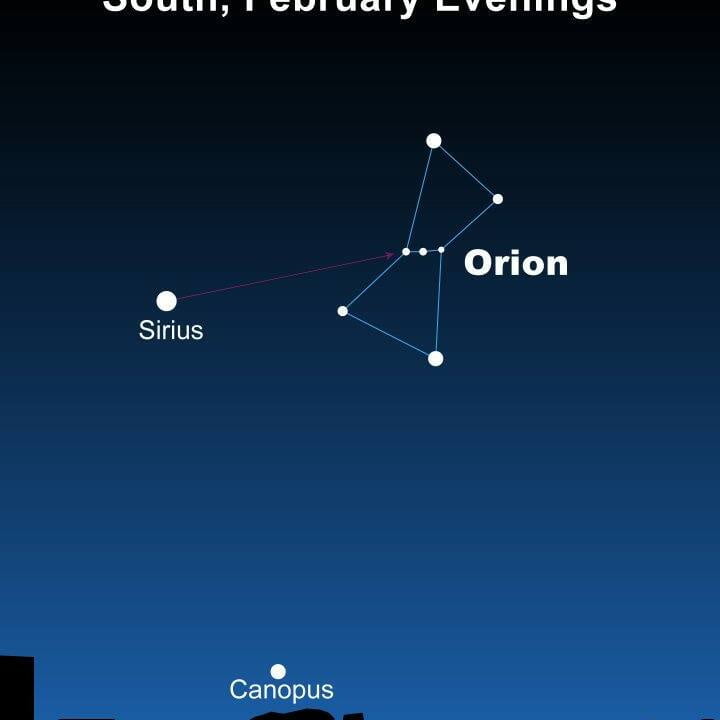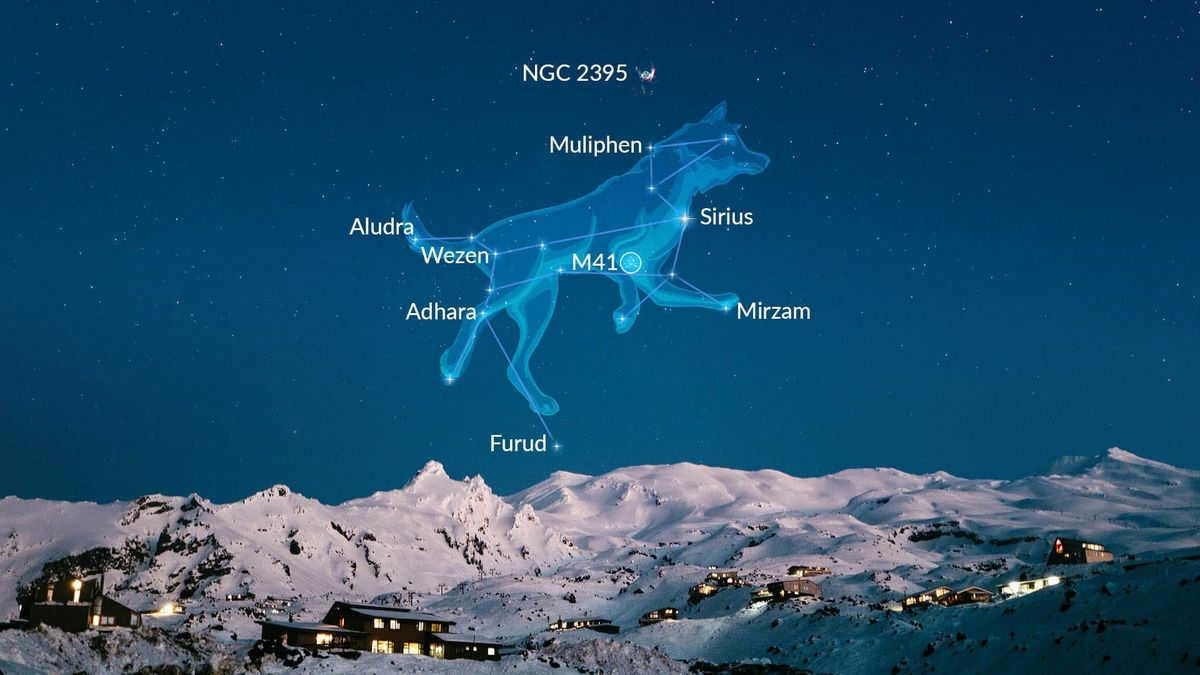
What is your knowledge about Sirius, the most brilliant star in the night sky, and its corresponding constellation, Canis Major? For instance, were you aware that there exists a star within the Canis Major constellation that outshines Sirius? Additionally, did you know that there is a star cluster called Pirate’s Treasure located in the same constellation? Continue reading to uncover more fascinating information!
What is the location of the star Sirius?
Sirius, the brightest star in the night sky, can be easily seen in the evening sky during this time of year. At around 7:30pm local time, you can find Sirius in the southeastern sky, positioned to the lower left of the Orion constellation. As the night progresses, Sirius will reach its highest point above the southern horizon at 9 p.m., and then it will gradually descend, eventually disappearing below the horizon by 2 a.m.
Despite being primarily visible in the Southern Hemisphere, Sirius can be observed in almost every part of the world, including locations as far north as 73° north latitude. In cities located in the northern regions, Sirius remains relatively low above the horizon. For instance, in St. Petersburg, the star only rises to an elevation of 13°.
You can easily locate Sirius by using the Sky Tonight app. To find it, simply open the app and click on the magnifying glass icon at the bottom left corner. Type “Sirius” in the search box and then tap on the magnifying glass icon. Sky Tonight will then show you the exact location of this star.
What is the popular name for Sirius?
Sirius is known as the “Dog Star” because it is the brightest star in the Canis Major constellation, which translates to “Big Dog” in Latin. The Greek meaning of Sirius is “burning” and “scorching”.
Another less common name for Sirius is Alpha (α) of the Big Dog. It is typically the most prominent star in the constellation.
What causes Sirius to shine so brightly?
Sirius emits such a brilliant light due to its incredible brightness, which is 25 times greater than that of the Sun. Moreover, despite being located just 8.6 light-years away from Earth, it is gradually moving closer to us, ensuring that its radiance will only increase over time! Additionally, Sirius is accompanied by a small companion, a white dwarf star known as Sirius B, affectionately referred to as Puppy by certain astronomers.
Sirius is famous for its brilliant bursts and shimmering. This phenomenon occurs because individuals in the Northern Hemisphere typically observe the star positioned low on the horizon, causing its intense light to traverse a thick layer of atmosphere. The atmospheric layers that cause stars to twinkle function similarly to minuscule refracting prisms, fragmenting the white light emitted by Sirius and haphazardly redirecting various colors (wavelengths) towards our vision.
The constellation known as Canis Major
Forming a triangular shape, the stars that make up the head of the celestial dog can be found to the upper left of Sirius. Unfortunately, these stars may not be easily visible in areas with a high concentration of city lights. Stretching across approximately 19° from nose to tail, which is roughly the equivalent of two clenched fists, the constellation is also about the size of one fist from ears to paws. The remainder of Canis Major is situated to the lower left of Sirius and consists of stars that are more readily observable.
The primary celestial bodies within the constellation of the Large Canine
Directly below Sirius, one can observe the luminous star Wesen, which signifies the rear of the Canine. Positioned just below and to the left of Wesen, one can identify the moderately bright star Aludra, denoting the tip of the Canine’s tail. Slightly above Wesen, there are two stars situated at a distance equivalent to the width of two fingers. These stars symbolize the Canine’s torso. The star on the left is referred to as the white Al Zara (HR 2580), while the star on the right is the fainter orange star Udra (HR 2653). Both stars are commonly known as the Omicron of the Large Canine.
Located towards the lower left of Wesen, the luminous star Adara represents the hind legs of the Canine. Occasionally, two additional dim stars are used to depict the hind legs.
The front paws of the dog represent the shining star Mirzam (also known as Beta of the Big Dog), positioned towards the lower right of Sirius. Mirzam outshines Sirius by a factor of 60. If Mirzam were situated at the same distance from Earth as Sirius, rather than being 500 light-years away, it would radiate 15 times more brightly than Venus!
Underneath Sirius, at the core of the Canis Major constellation, lies a compact and luminous group of stars known as Messier 41, alternatively referred to as the Little Beehive Cluster. It can be easily spotted using binoculars. This cluster is situated at a distance of 2,300 light years and is composed of numerous brilliant golden-hued stars as well as a multitude of fainter stars.
To the upper left of Wesen, you can find another star cluster called NGC 2354. Additionally, there is a more breathtaking cluster located to the left of Wesen. This cluster is called the Tau Big Dog Cluster (NGC 2362), also recognized as the Pirate’s Treasure Cluster.
An intriguing small nebula with a distinct shape can be observed to the upper left of Sirius. This nebula, known as NGC 2359, emits a blend of red and blue light. Due to the presence of gas “wings” encircling its center, it has garnered the nicknames of Thor’s Helmet, the Duck Nebula, and the Flying Eye Nebula.
Now that you have learned how to locate the star Sirius in the night sky and what other celestial objects can be seen in the constellation Canis Major, try to spot them on a clear night.
We hope you enjoy clear skies and successful stargazing!
Sirius, also known as Alpha Canis Majoris, is the most luminous star in the sky. It is located 8.60 light years away from Earth and belongs to the constellation Canis Major, also known as the Big Dog. Although it may not be the physically brightest star, its proximity to us makes it appear as the brightest. Interestingly, Sirius is gradually moving closer to us, resulting in an increase in its brightness. This trend will continue for another 60,000 years before reversing. Sirius will maintain its status as the brightest star for another 210,000 years.
With a magnitude of -1.46, Sirius is twice as bright as Canopus, a star in the constellation Carina. However, in terms of actual brightness, it is inferior to Canopus and Rigel, which are located at greater distances from Earth.
Sirius originates from the Latin term meaning “to radiate”. It is also commonly referred to as the Canine Star.
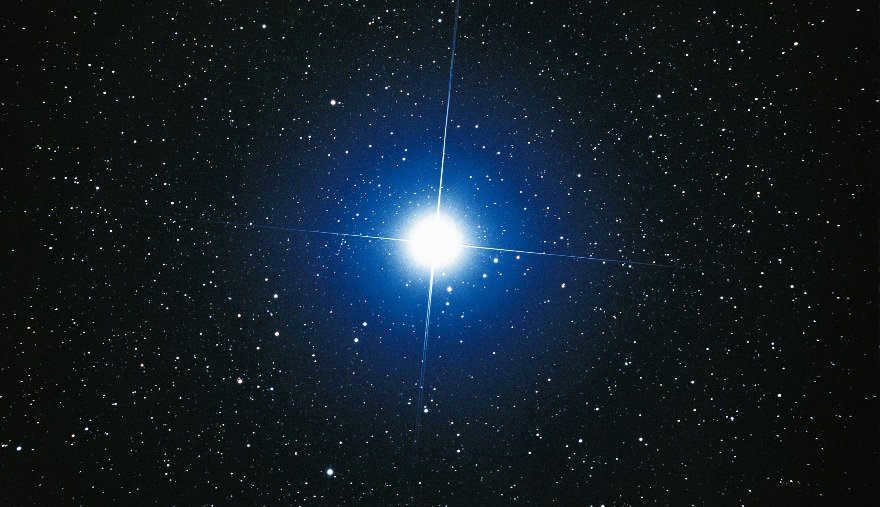
During ancient times, the rising of this celestial body indicated the Nile’s emergence from its banks, while in Greece it signaled the arrival of summer (from July 3 to August 11). The heliacal rising refers to the star’s first appearance above the eastern horizon before dawn.
Alpha Canis Majoris, commonly known as Sirius, may appear as a solitary star, but in reality, it is a binary star system consisting of two stars: Sirius A, a white main-sequence star (A1V), and Sirius B, a white dwarf (DA2). These two stars have a period of 50.1 years and an average distance 20 times greater than that between the Earth and the Sun. The angular separation between them ranges from 3 to 11 angular seconds.
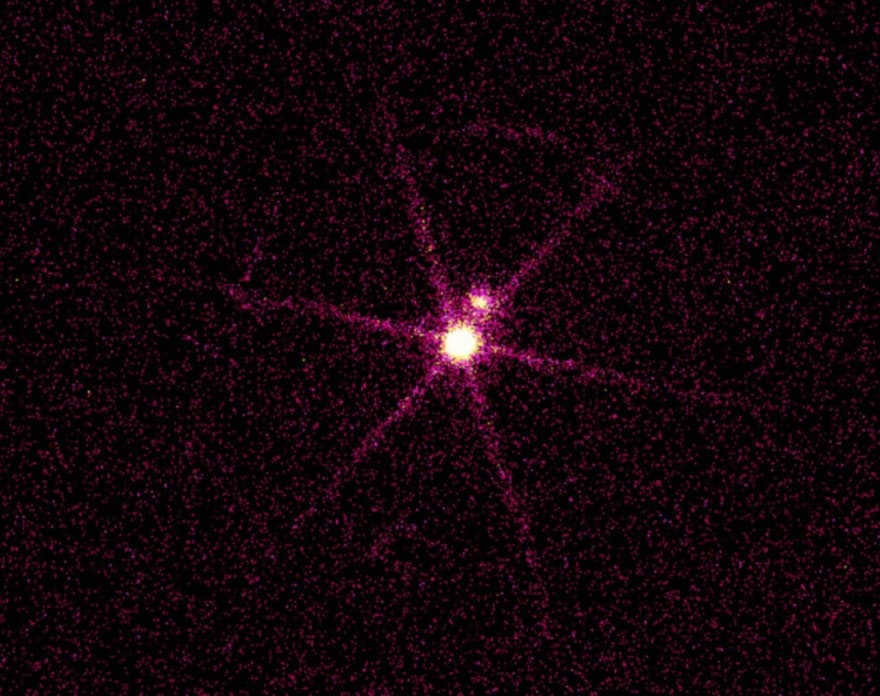
An X-ray image of the Sirius system, which is located 8.6 light-years away, is displayed here. In front of you, there are two sources of light. The brighter one is Sirius B, a white dwarf star that is heated to a scorching temperature of 25,000°C. The dimmer light comes from Sirius A, a star whose mass is twice that of the Sun. Interestingly, if you were to observe the Sirius system through optical instruments, Sirius A would appear as the brightest star in the sky, even though Sirius B actually emits 10,000 times more light. This is because of their proximity to each other. It wasn’t until 1862 that the existence of Sirius B was discovered by Alvan Clarke while testing the world’s most advanced telescope.
It is worth noting that every 50 years, there is a maximum convergence point where the Sirius system can only be distinguished with a 12-inch telescope and under favorable conditions. This period of convergence is also characterized by the formation of powerful magnetic storms between Sirius A and Sirius B, which causes an acceleration in their rotation.
Sirius A is approximately twice the mass of the Sun and 25 times brighter. Its temperature reaches 9940 K. Meanwhile, Sirius B is roughly 10,000 times brighter, but it is only visible in the X-ray spectrum. It orbits its companion along an elliptical path, with a temperature of 25200 K.
Sirius A is classified as an Am star, which means it contains elements heavier than helium, such as iron (316% of the solar atmosphere).
The age of the Sirius system is estimated to be between 200-300 million years. Originally, it consisted of two luminous stars, with Sirius B having a mass 5 times greater than the Sun. However, through the process of evolution, it transformed into a red giant and eventually became a white dwarf approximately 120 million years ago.
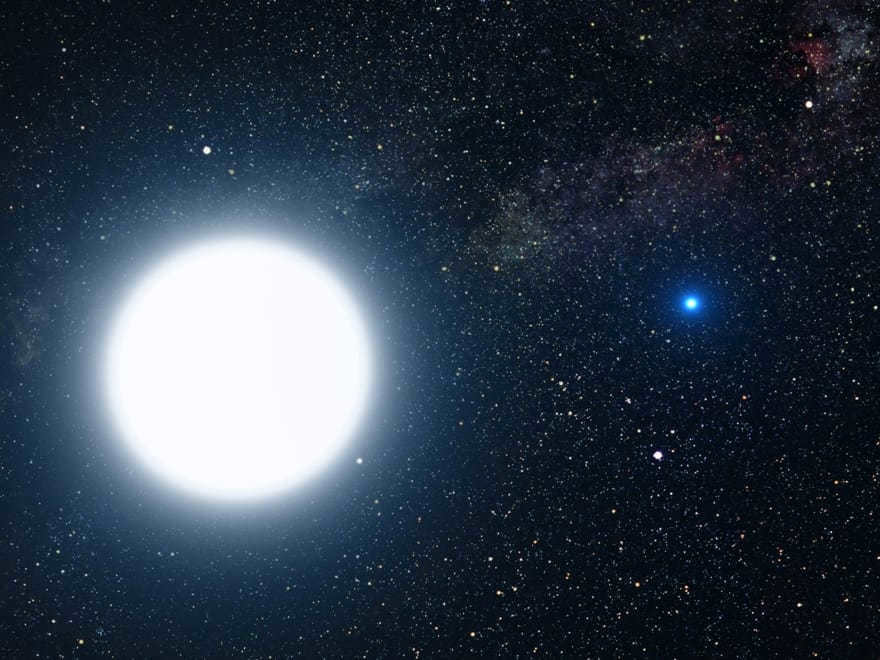
Sirius B is one of the most massive dwarfs, with a mass that almost matches that of the Sun (0.98). It has a diameter of approximately 12,000 kilometers. The discovery of its binary companion was credited to Friedrich Bessel, while Alvan Clarke observed it in 1862 using the largest lens available at the time.
There is a possibility that the Sirius system contains a third large component, although its existence has yet to be confirmed. If this component does exist, it would have a relatively low mass of 0.06 solar masses and an orbital period of 6 years.
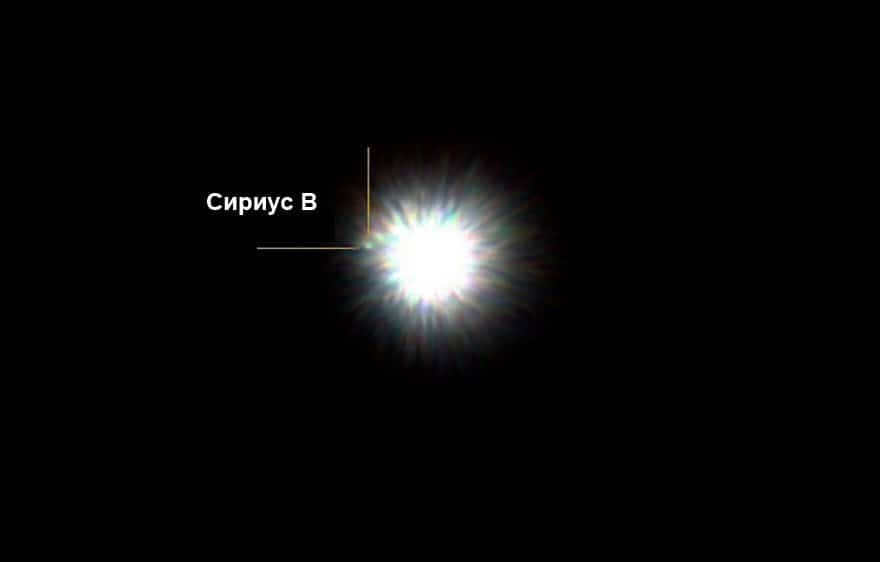

It was Walter Adams who first discovered that Sirius B is a white star. He utilized a 60-inch reflector at the Mount Wilson Observatory to observe it. He studied the star’s spectrum and eventually determined that it was a white dwarf. It wasn’t until 2005, with the assistance of the Hubble telescope, that researchers were able to precisely measure its diameter and mass.
Facts
Records of Sirius can be traced back to the 7th century, when the poet Hesiod made a reference to it in his work Works and Days.
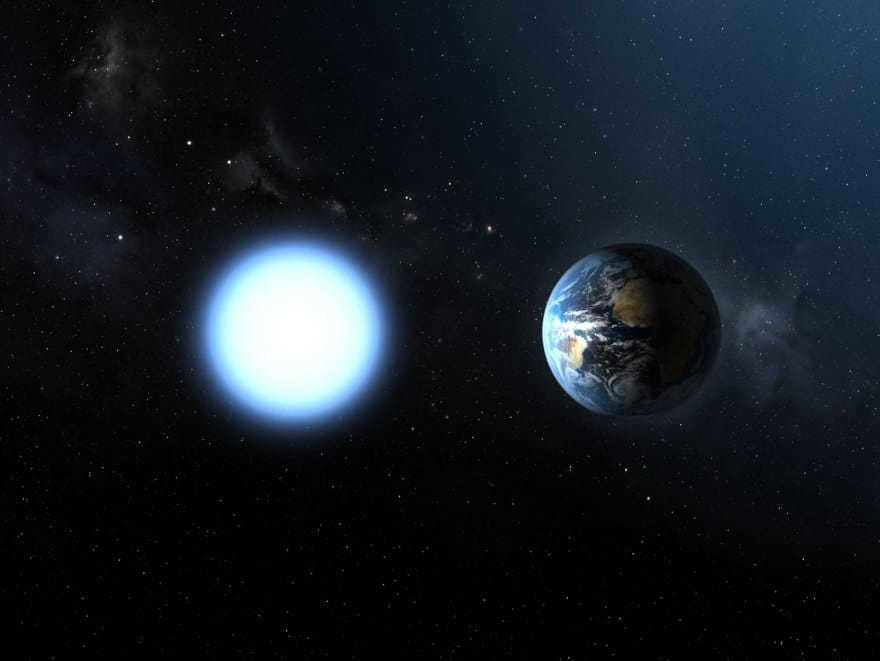
Comparison of Sirius B to Earth
Sirius has more than 50 designations. In astrolabes and Western Europe, the star was known as Alkhabor. In Scandinavia, it is referred to as the torch of Loki (Lokabrenna). Sirius is only surpassed in brightness by the Moon, Venus, Jupiter, and occasionally Mercury and Mars.
Sirius also played a significant role in Edmund Halley’s work, as it led him to contemplate proper motion. In 1718, he compared modern data with the information in Ptolemy’s Almagest and discovered that the positions of the stars had changed over a span of 1800 years.
Sirius was also the first star to have its speed accurately measured. In 1868, William Huggins mistakenly determined that the star was moving away from the Sun at a rate of 40 km/s. In reality, it is actually moving towards us at a speed of 7.6 km/s.
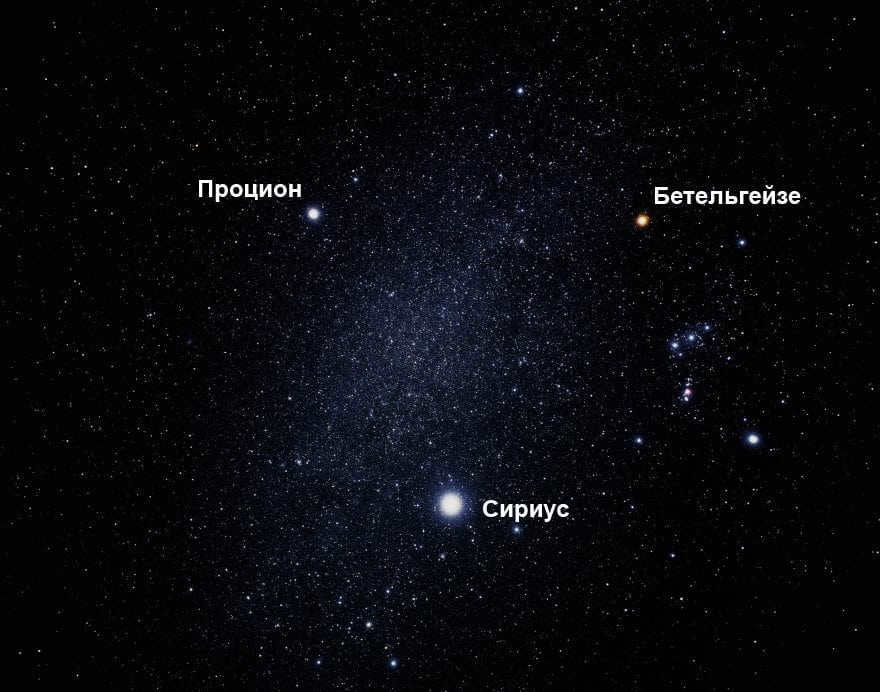
The Winter Triangle is composed of Procyon (top left), Betelgeuse (top right), and Sirius (base).
In combination with Procyon and Betelgeuse, it creates the Winter Triangle asterism. Voyager 2 was launched in 1977. It has already departed from the outer planets and will approach Sirius at a distance of 4.3 light-years in 296,000 years.
At one time, this star was believed to be a member of the Moving Group of the Big Dipper. Einar Herzsprun stated this in 1909. However, doubts arose between 2003 and 2005 as the stars in the group were expected to be around 500 million years old, whereas Sirius is too young.
Nevertheless, this star is part of the Sirius Superscope, which also includes Beta Ascendant, Alpha Veronica Hair, Beta Chalice, Beta Eridanus, and Beta Serpent.
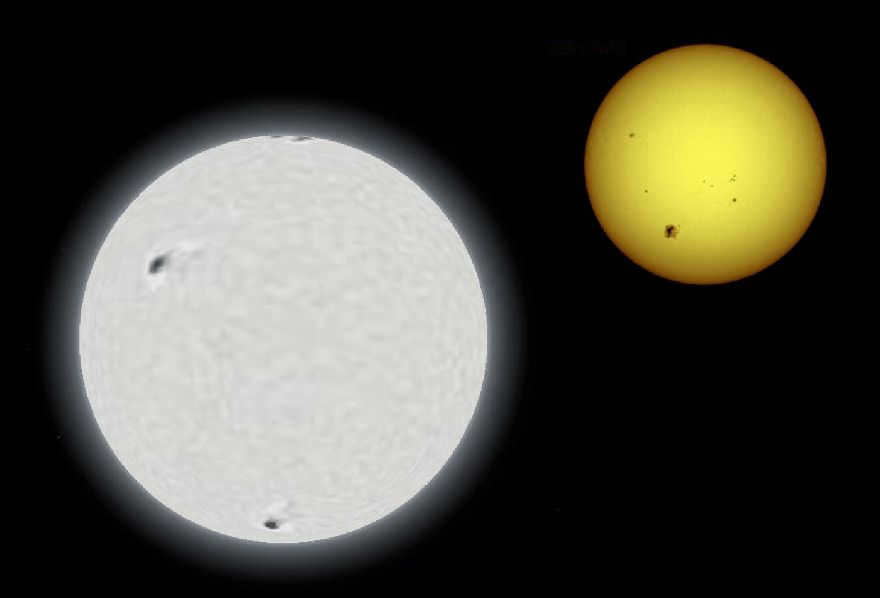
Comparison of Sirius A and the Sun
In 1959, R. Hanbury, B and R. Twiss were able to determine the size of Sirius A. The first spectrum of Sirius B was obtained in 1920, while the first satellite photograph was taken in 1970.
The star’s color has been a subject of controversy for many years, as ancient observers described it as red. For instance, Ptolemy in 150 AD believed this to be the case, and he was supported by Seneca. However, there were also scientists who thought it appeared blue or white. It is likely that these varying observations were influenced by the star’s position relative to the horizon, as the Earth’s atmosphere can affect the perceived color.
Many people have considered the star’s intermittent flickering to be a unidentified flying object (UFO). However, the reality is that the star’s light must pass through the Earth’s atmosphere, which contains variations in temperature and density.
Sirius in mythology and society
The ancient Egyptians referred to Sirius as Soldet, represented by a hieroglyph of a star and a triangle. The people even developed a calendar based on the star’s rising. Its appearance marked the start of a new year, and a celebration was held in its honor. When Sirius vanished before dawn, the Nile would recede from its banks. This occurrence took place prior to the summer solstice.
During a period of 70 days, the star was not visible in the sky, leading the Egyptians to believe that Isis and Osiris had descended to the underworld. The Egyptians also observed that the heliacal ascension of the star occurred every 365.25 days. They regarded Sirius as the gateway to the afterlife and refrained from burying their dead during the 70-day interval when the star was absent. Some theories suggest that the positioning of the pyramid at Giza was precisely aligned with the positions of Sirius and the three stars of Orion’s belt.
The Greeks recognized that the appearance of Sirius heralded the arrival of a hot season, often describing it as “burning”. Some even offered sacrifices to the star and considered it a symbol of good fortune. Conversely, if Sirius appeared hazy and dim, it was seen as a harbinger of death and widespread diseases.
In India, Swana was the name given to the dog belonging to Prince Yudhisthir. Together, they embarked on a search for the heavenly gate, but upon finding it, the loyal dog refused to be left behind. Prince Yudhisthir made the selfless decision to forgo entering heaven without his faithful companion. In recognition of their unwavering loyalty, God allowed both of them to enter the gates.
The mention of Sirius can be found even in the Koran, where it is referred to as the Mighty Star. Within the Cherokee tribe, Sirius was known as the star of the beast, while the Inuit referred to it as the moon dog. The remarkable thing is that the Dogon tribe possessed knowledge that could not be observed without the aid of telescopes. They were able to determine that Sirius is a binary star system with an orbital period of 50 years. Furthermore, the tribe had been observing this star for over 5000 years, and their legends suggest that our species evolved from the amphibious Nommo race of Sirius.
Where to Find the Star
The star known as Sirius can be observed from any location south of 73°N. However, if you are situated farther north, it will not appear very high above the horizon. Interestingly, Sirius is considered circumpolar, meaning it never sinks below the horizon line.
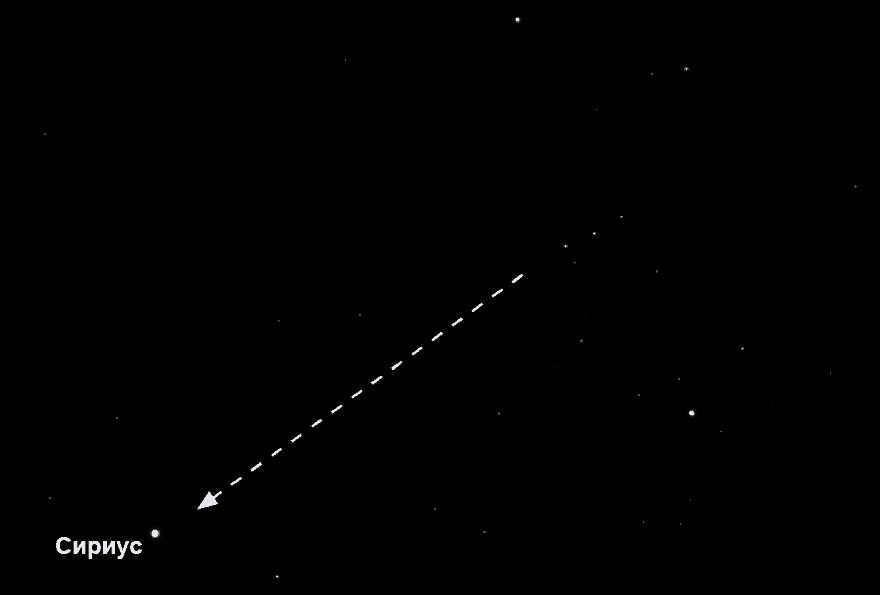

Due to the phenomenon of precession, the star known as Alpha the Big Dog will gradually shift its position to the south, and by the year 9000, it will no longer be visible from most locations in north-central Europe. However, in the year 14000, the star Vega will take its place as the polar star.
To locate the star Sirius, one can utilize the stars that make up Orion’s belt, specifically Alnilam, Alnitak, and Mintaka. For observers residing in northern latitudes, Sirius can be found in the southeastern, southern, and southwestern parts of the sky during the winter season. Additionally, in the eastern region, it can be spotted before dawn in the late summer months.
- Sirius is identified as the Alpha star of the Big Dog constellation.
- Constellation: Big Dog.
- Coordinates: 06h 45m 08.9173c (right ascension), -16° 42′ 58.017″ (declination).
- Distance from Earth: 8.6 light years.
- Orbital period: 50.090 years.
Designations: Sirus, Dog Star, α Canis Majoris, 9 Canis Majoris, HD 48915, HR 2491, BD -16° 1591, GCTP 1577.00 A/B, GJ 244 A/B, LHS 219, ADS 5423, LTT 2638, HIP 32349, B:EGGR 49, WD 0642-166.
Physical traits and orbital characteristics
- Spectral classification: A1V.
- Apparent magnitude: -1.47.
- Absolute magnitude: 1.42.
- Mass: 2.02 times that of the Sun.
- Radius: 1.711 times that of the Sun.
- Luminosity: 25.4 times that of the Sun.
- Temperature: 9940 K.
- Age: 2-3 million years.
- Spectral classification: DA2.
- Apparent magnitude: 8.30.
- Absolute magnitude: 11.18.
- Mass: 0.978 times that of the Sun.
- Radius: 0.0084 times that of the Sun.
- Luminosity: 0.026 times that of the Sun.
- Temperature: 25200 K.
Our star map is a useful tool for locating Sirius in a telescope or exploring its appearance and position in space using online 3D models.
Sirius A, the brightest star in the night sky and the most visible, is actually a double star. It shines with a luminosity that is 22 times greater than that of the sun. The reason for Sirius’s remarkable brightness is its relatively close proximity to Earth. Although Sirius can be observed from all regions of the Earth, it is not visible from the northernmost regions. Located 8.67 light-years away from our solar system, Sirius is one of the closest stars to us. It is classified as a main-sequence star with a spectral class of A1 and is a member of the constellation Canis Major.
The estimated age of the Sirius system is approximately 230 million years, with some estimates ranging from 200 to 300 million years. Initially, the Sirius system consisted of two blue-white stars, both belonging to spectral class B. One of the stars, called Sirius B, had a mass of 5 solar masses, while the other, Sirius A, had a mass of 2 solar masses. However, around 120 million years ago, Sirius B, being the more massive star, went through a phase where it burned through its fuel and became a red giant. Eventually, it shed its outer shell and transformed into its current state as a white dwarf. With a mass of 1.02 solar masses, Sirius B is one of the heaviest white dwarfs known, as most white dwarfs typically have a mass of 0.5-0.6 M.
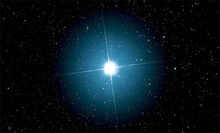
Location and Observation of the Star
Sirius can be found in the constellation of Canis Major. It is visible in the night sky from various locations, including South Murmansk and Norilsk. Sirius rises to a sufficient height above the horizon and can be observed up to the latitudes of Petrozavodsk.
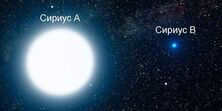
In the middle latitudes of Russia, Sirius can be observed in the southern part of the sky. During the fall season, it becomes visible in the morning, while in winter it remains visible throughout the night. In spring, it can still be seen for a certain period of time after sunset. However, during the summer months, Sirius becomes hidden in the Sun’s rays and cannot be observed from Russia. It can only be seen from the middle latitudes of the Southern Hemisphere, where the Sun rises later and sets earlier than Sirius, while also being lower above the horizon.
Sirius holds the position of the sixth brightest object in the Earth’s sky. Only the Sun, the Moon, and the planets Venus, Jupiter, and Mars outshine it during its prime visibility period.
The main point of reference for observation is the belt of the constellation Orion. By drawing a straight line through the belt, one side indicates the northwest direction, where Aldebaran can be found, while the other side points to the southeast, where Sirius is located. Even without knowledge of the cardinal directions, it is impossible to mistake Sirius and Aldebaran, as these stars differ significantly in terms of color and brightness [17].
If one is aware of the cardinal directions, it is possible to locate Sirius using other stars: Sirius can be found southwest of the bright star Procyon, approximately 35 degrees to the north of Canopus, around 30 degrees to the south of Alchena (a star in the Gemini constellation), or 15 degrees to the east of Arneb (a star in the Hare constellation).
At present, Sirius is easily observable in the Northern Hemisphere, but due to the phenomenon of precession, in approximately 11,000 years, Sirius will no longer be visible in Europe. Additionally, the constellation Canis Major, in which Sirius resides, will move closer to the celestial pole, while the South Pole of the Earth will align with the constellations Vela or Columba. Conversely, the North Pole of the Earth will be in close proximity to the star Vega during this period. It is important to note that ancient civilizations, flourishing around ten thousand years ago in Europe, were oblivious to the existence of Sirius. Instead, they had the opportunity to witness the celestial marvels of Centaurus, accompanied by the star Toliman engaged in battle with the Wolf, and in Centaurus’ feet, the Southern Cross.
The movement of Sirius itself is highly notable. Once the full precession cycle of 25,776 years is completed, Sirius will have moved far from its current position, shifting towards the southwest. It will then be situated roughly midway between the stars Mirtsam and Furid in the constellation Canis Major, making it easily observable only to the south of central Russia.
Meanwhile, approximately 25,776 years ago (around 24,000 BC), Sirius was positioned at the center of the present-day Unicorn constellation.
The Solar System is being approached by Sirius at a velocity of 7.6 km/s, thus causing a gradual increase in the star’s apparent luminosity over time.
Organizing the celestial body [ ]
Sirius is a binary star system composed of an A1 spectral class star, known as Sirius A, and a white dwarf companion, known as Sirius B. These two stars orbit around a common center of mass with a period of approximately 50 years. The average distance between Sirius A and Sirius B is roughly equivalent to the distance between the Sun and Uranus, which is about 20 astronomical units (a.u.). The Sirius system is estimated to be between 225 and 250 million years old, similar to the age of the Sun.
Interferometry measurements have determined that the angular diameter of Sirius A is (5.936±0.016)×10 -3 angular seconds in a flat disk model. However, when taking into account the darkening towards the star’s edge, the angular diameter increases to (6.039±0.019)×10 -3 angular seconds. This translates to a linear size of approximately 1.7 times that of the Sun.
The rotation velocity of Sirius A around its axis at the equator has a relatively small projection onto the line of sight, measuring about 16 kilometers per second. This results in Sirius A having an almost spherical shape.
Sirius A has approximately 660 million years left on the main sequence before it undergoes a transformation into a red giant. Eventually, it will shed its outer layers and evolve into a white dwarf.
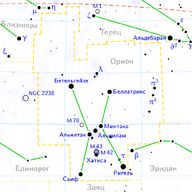
Sirius B, located in the constellation Canis Major, is an exceptionally massive white dwarf with a mass equivalent to that of our Sun. Most white dwarfs typically have a mass of around 0.6 to 0.7 solar masses, making Sirius B stand out as one of the heaviest known white dwarfs. Despite its mass, Sirius B’s size is incredibly small, with a volume more than a million times smaller than the Sun. In fact, it is about the size of a globe.
Prior to becoming a white dwarf, Sirius B underwent various stages of stellar evolution. It first existed as a main-sequence star before progressing into the red giant stage. The shedding of outer layers that led to the formation of the white dwarf occurred approximately 120 million years ago. During its main-sequence stage, Sirius B had a mass of 5 solar masses and belonged to the spectral class B4 or B5. The spectrum of Sirius B reveals an abundance of pure hydrogen.
Spectral environment of the star [ ]
| Star | Spectral type | Distance, light years |
| Procyon | F5 V-IV; DQZ | 5.2 |
| Ross 614 | M4.5 Ve; M8 V | 5.5 |
| Leuthen’s Star | M3.5 Ve | 5.8 |
| Kapteyn’s star | M1 V | 7.5 |
| Epsilon Eridanus | K2 V | 7.8 |
| Sun | G2 V | 8.6 |
| LHS 1565 | M5.5 V | 8.9 |
| Wolf 359 | M5.8 Ve | 9.0 |
| DX Cancer | M6.5 Ve | 9.2 |
| Proxima Centauri | M5.5 Ve | 9.3 |
| Alpha Centauri | G2 V; K1 V | 9.5 |
| LTT 12352 | M3.5 V | 9.9 |
The whole atmosphere is aligned with Sirius; Sirius is not a significant offender in terms of spectral classification.

Sirius, which is situated in the southern constellation of the Big Dog, is the most brilliant star that can be seen in the night sky. This remarkable celestial body is actually a binary star system, and it has been well-known since ancient times. For instance, in ancient Egypt, the first appearance of Sirius was a sign that the Nile River would soon begin to flood. Similarly, this star was also widely recognized in ancient Greece, as well as in the Mayan and Polynesian civilizations.
In ancient Greece, Sirius was commonly associated with the dog of the mighty hunter Orion, as described by Homer in “The Iliad.” He wrote, “Sirius rises late in the dark, liquid sky on summer nights, a star among stars, Orion’s dog they call the brightest of all…”
Visibility
The concept of visibility refers to the ability of something to be seen or noticed. It is a measure of how easily something can be observed or perceived. In the context of web design and development, visibility is often used to describe the appearance and accessibility of website elements.
The visibility of an element can be controlled using various CSS properties and techniques. For example, the “display” property can be used to hide an element completely by setting it to “none”. This will remove the element from the layout flow and make it invisible to the user.
Another commonly used property is “visibility”, which can be set to “hidden” to make an element invisible without affecting its position in the layout. This allows the element to still take up space on the page, but it will not be visible to the user.
In addition to these CSS properties, there are also JavaScript methods that can be used to control the visibility of elements dynamically. For example, the “style” property can be used to modify the CSS of an element, including its visibility.
Overall, understanding and controlling the visibility of elements is an important aspect of web design and development. By manipulating the visibility of different elements, designers and developers can create engaging and user-friendly websites.
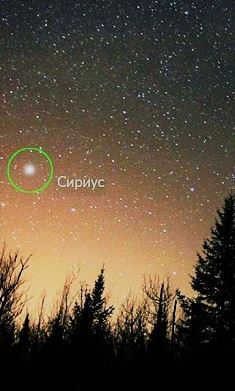
When it comes to brightness, Sirius is only outshone by the Moon, Jupiter, and Venus, and occasionally Mercury and Mars. You can spot Sirius from almost anywhere on Earth, except for beyond 73 degrees north latitude. In northern regions, you can still see Sirius, but it appears low in the sky (in St. Petersburg, it never rises more than 13 degrees above the horizon).
In early July, below the equator, Sirius is visible both in the evening after sunset and in the morning before sunrise. During the Dog Days (from July 23 to August 24), you can see Sirius in southern Europe shortly before sunrise.
There are even times when you can see Sirius with the naked eye during daylight.
The visible brightness of Sirius B (a companion of Sirius A), is 8.30, and it would be readily detectable in a telescope if the observer’s view was not obstructed by the greater luminosity of Sirius A.
There are indications that Sirius was believed to possess a reddish hue in ancient times, but this inconsistency is presently ascribed to the dispersion of light in the atmosphere when observing a white star during sunrise or sunset.
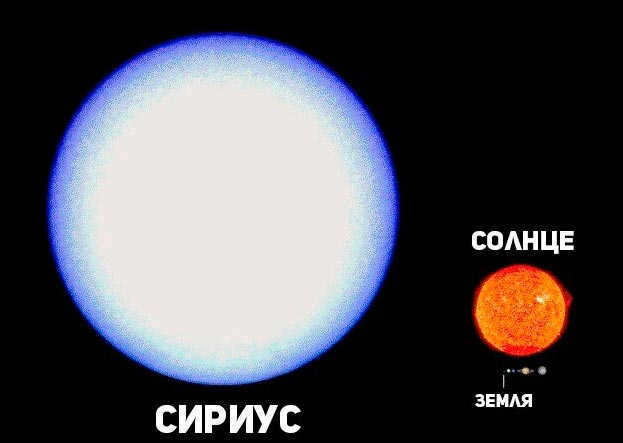
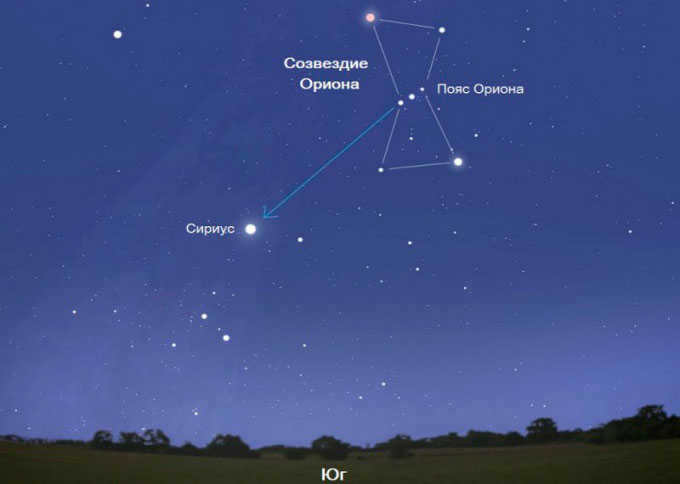
In Chinese astrology, Sirius is referred to as the “heavenly wolf” star. The ancient Chinese observed a celestial bow and arrow in the night sky, gliding across the southern hemisphere in such a way that its tip points directly towards Sirius’ wolf.
Ancient Egyptian records mention the star Sopdet (also known as Sotis or Setis in Greek), which translates to “expectant woman”. This reference can be found in the earliest known astronomical documents.
During the time of the Middle Egyptian Empire, the Egyptian calendar was established based on the heliacal rising of Sirius. This means that the calendar’s first day was determined by the moment when Sirius becomes visible in the western sky, shortly before sunrise. Astrological predictions for Egypt were made based on the brightness and hues of Sirius’ flickering during this rising.
The significance of the initial sighting of Sirius lies in its indication of the onset of the Nile flood season prior to the summer solstice, following a period of 70 days when the star is not visible. This period represents the journey of the goddess Isis and the ruler of the underworld, Osiris, through the realm of the dead.
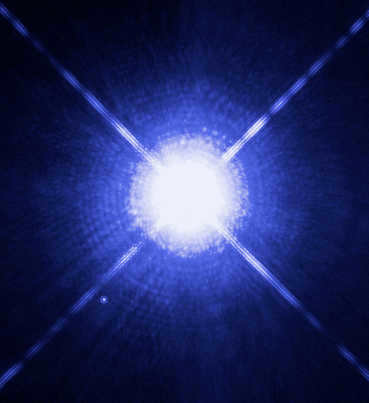
The connection between Sirius and the Egyptian calendar provides modern scientists with a more accurate way to navigate the chronology of Ancient Egypt. This is because the ancient Egyptians did not have a standardized dating system.
According to Greek mythology, the goddess of hunting, Artemis, accidentally kills her lover Orion. This event saddened the goddess so much that she immortalized Orion in the sky as a constellation, allowing her to always see him. By his side, she placed his loyal dog, Sirius.
In ancient Greece, the period of time after Sirius appeared was known as the “dog days,” and the Romans referred to these days as vacations.
The renowned scientist Claudius Ptolemy, who lived in Alexandria, Egypt, during the late Hellenistic period, compiled a comprehensive star catalog in the 2nd century AD. Within this catalog, Sirius served as a marker for the central meridian of the Earth.
In Sanskrit, this celestial body is known as the “deer hunter,” symbolizing Rudra (Shiva), the supreme deity in the Hindu pantheon. In Scandinavian culture, Sirius was referred to as the “torch of Loki,” representing Loki, the god associated with cunning, deceit, and trickery. Additionally, during the Middle Ages, astrology connected Sirius with beryl and juniper trees, considering it as one of the fifteen fixed stars.
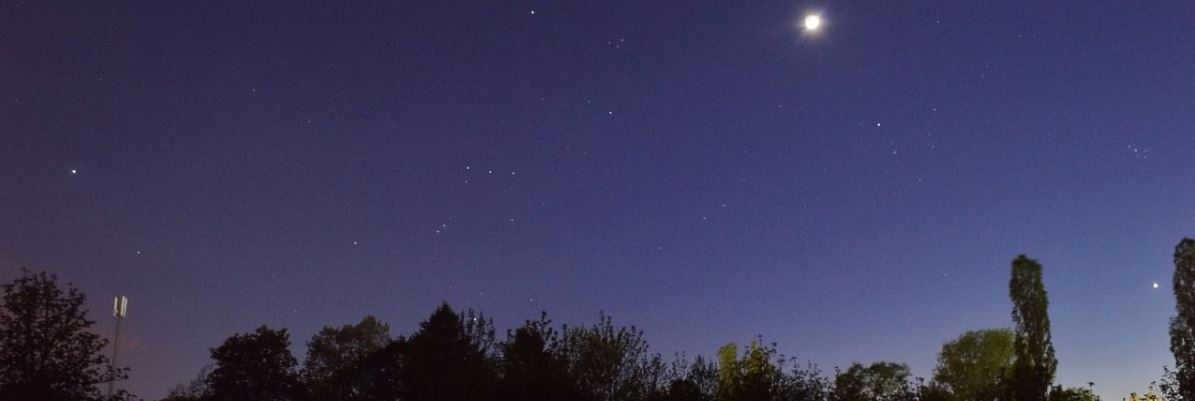
The Cherokee Indian people associated Sirius with Antares as a pair of sentinels guarding either side of the “Path of Souls”; other indigenous tribes referred to it as the “Coyote Star” and the Alaskan Eskimos regarded it as their “Moon Dog”. In Polynesia, another part of the world, the brightest stars, including Sirius, were utilized for navigation purposes amidst the multitude of islands and atolls in the Pacific Ocean.
The Dagon people of Mali are believed to have possessed knowledge of Sirius even prior to the invention of telescopes; specifically, the Dagons were aware of the presence of a third star within the system.
In the 18th century, Immanuel Kant, the renowned Prussian philosopher, contemplated the celestial body known as Sirius. Being a prominent source of light in the European sky, with no other nearby stars shining as brightly (such as Canopus, Alpha Centauri, or Ahernar), Kant concluded that Sirius is the central force that governs the movement of all other celestial entities in the universe.
Astronomical facts and the discovery’s historical background
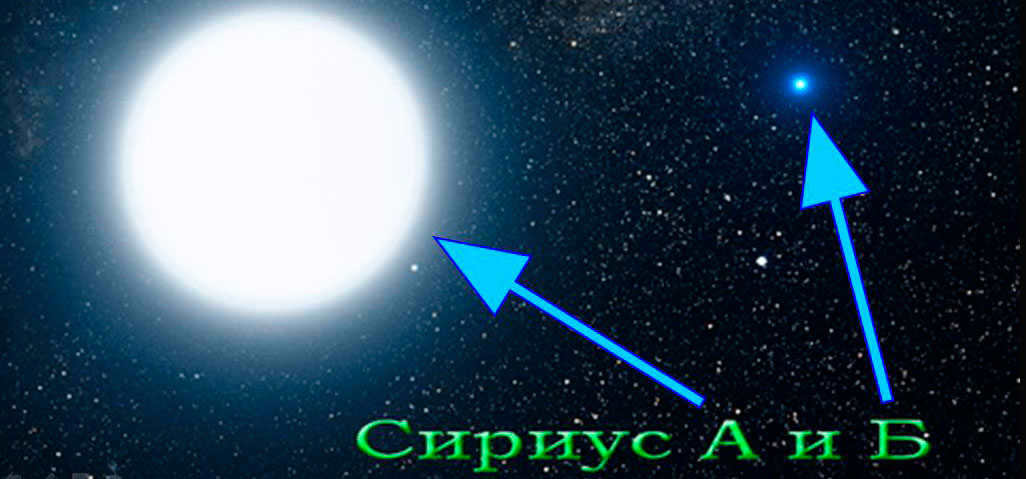
There are multiple scientific names for Sirius, each consisting of an abbreviation and a number. In the 17th century, Bayer introduced a naming system that assigned stars in each constellation a name based on their apparent brightness using the Greek alphabet, followed by the Latin name of the constellation in the genitive case. In this system, Sirius was designated as Alpha Canis Maioris, meaning Alpha of the Big Dog.
The primary component of the Sirius system is known as Sirius A. It is a white star with a surface temperature of approximately 9,700 C and is located about 8.6 light-years away from the solar system. As a result, it is the seventh nearest star to the Sun.
It was revealed that there is a binary star system
Sirius B, a faint white dwarf, was accidentally discovered near Sirius A in 1862 by Alvan Graham Clark, a telescope maker, while testing his product.
The separation between the two white stars in the Sirius system is approximately 20 astronomical units (comparable to the major semi-axis of Uranus’ orbit), and they have an orbital period of 50 years. The age of the system is estimated to be around 230 million years.
Sirius A has a mass of about 2 times that of the Sun, while Sirius B has a similar mass to the Sun. Sirius A has a diameter of 1.7 times that of the Sun, while Sirius B is roughly the size of Earth, measuring 12,000 km in diameter.
There have been observations indicating that there might be a third star, known as Sirius C, in the Sirius system. It is believed to be a red dwarf with a mass equivalent to one-fifth of the sun’s mass. The proposed orbit of Sirius C around Sirius A is elliptical and takes approximately 6 years to complete. However, the existence of this object is still a subject of debate as it has not been directly observed.
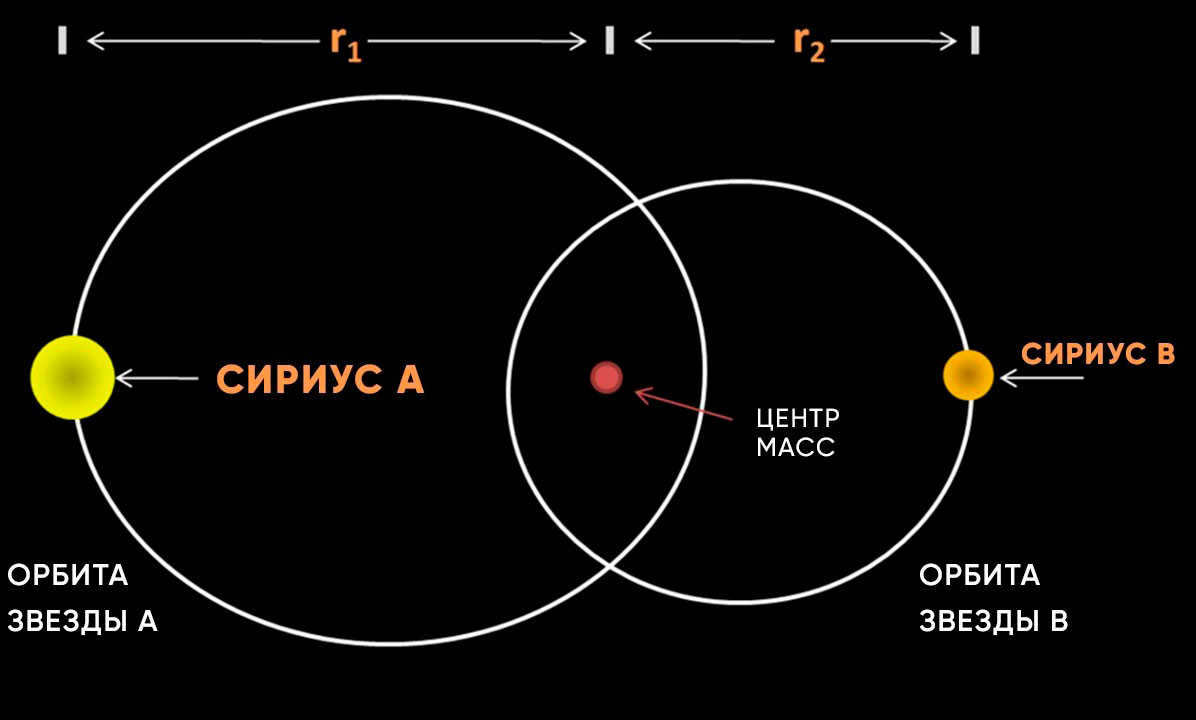
Sirius holds the distinction of being the inaugural star to have its motion speed measured; as per the latest data, it is approaching us at a velocity of 7.6 km/s. It is projected to reach its closest distance in approximately 64 thousand years before commencing its journey away from us.
By the time 210 thousand years elapse, Sirius will have moved so far away from our solar system that the title of the brightest star in the sky will be passed on to Vega, which hails from the Lyra constellation.
The destiny of this stellar system
The spectrum of Sirius implies that the star possesses a significant amount of iron. Nevertheless, it is plausible that this feature is exclusive to the star’s external layers. It is anticipated that in one billion years, Sirius A will deplete its core’s hydrogen reserves, subsequently transforming into a red giant and ultimately concluding its existence as a white dwarf.
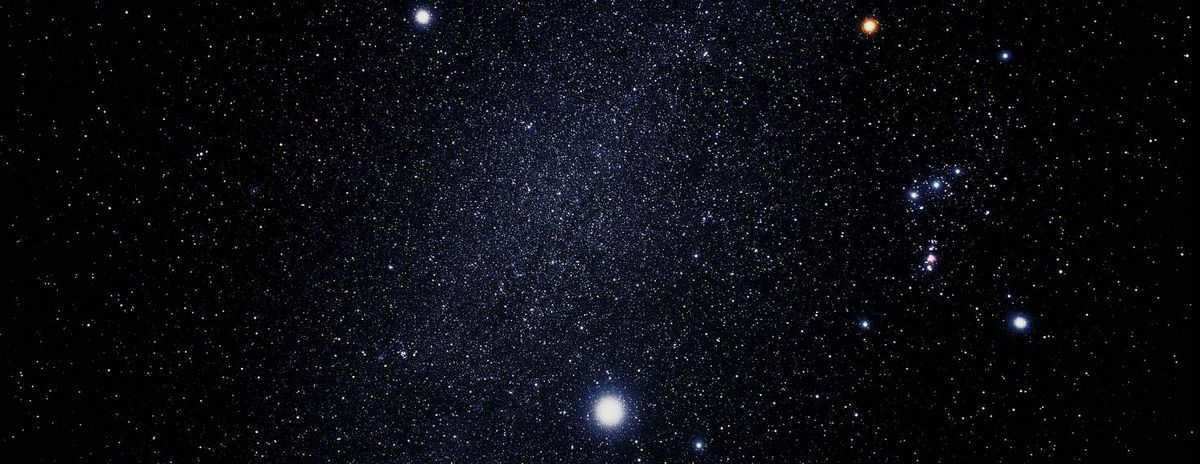
Sirius B lacks any internal sources of energy, therefore it will gradually lose heat over the course of the next 2 billion years, with the dissipation of this heat occurring into the vastness of outer space. The composition of Sirius B primarily comprises carbon and oxygen, while its outer atmosphere is comprised almost entirely of hydrogen.
The potential for life in its vicinity
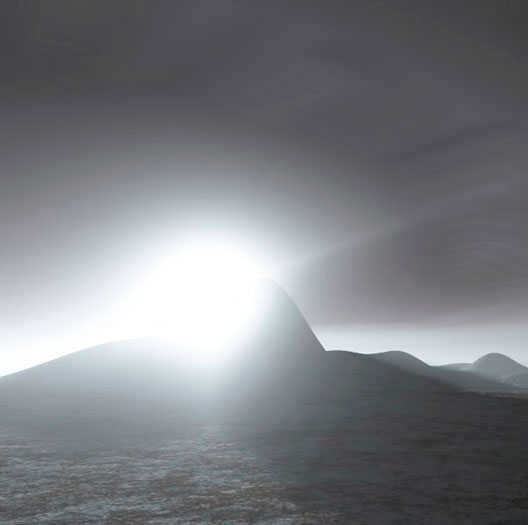
Sirius, the most luminous star in the nighttime sky, is situated in the constellation Canis Major.
To sustain life, a planet would need to be located at a distance of 4.7 astronomical units from Sirius A.
Unfortunately, this distance would not allow for a stable orbit due to the gravitational disturbances caused by the presence of Sirius B. Any potentially habitable planet would be at risk of destruction during the red giant phase.
Furthermore, if a planet were to form after this stage, it would be bombarded by a continuous stream of comets and asteroids, similar to the early solar system’s dust disk that has been discovered near Sirius.

Popularity
Sirius is well-known in literature and frequently appears in science fiction films.
In 1752, the French philosopher Voltaire wrote a short story titled Micromegas, which could be considered an early example of science fiction. The story revolves around a creature from Sirius named Micromegas.
The characters in the novel A Date with Rama by Arthur C. Clarke and Gentry Lee embark on a journey to the Sirius system aboard the spaceship Endeavor.
System’s distinguishing features
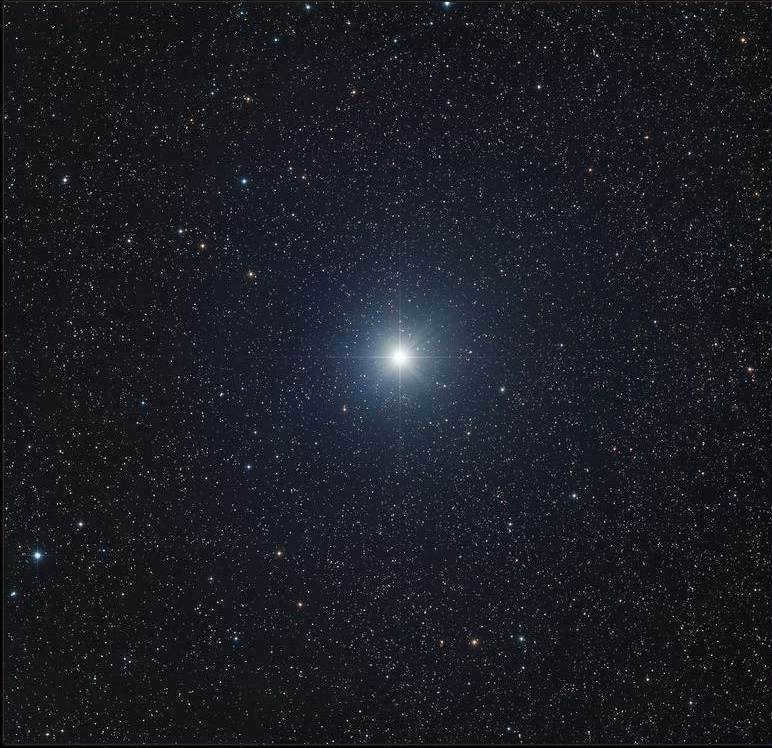
The most prominent celestial body in the heavens is unquestionably Sirius. It illuminates the area of the Canis Major constellation and can be easily observed in the winter months in the Northern Hemisphere.
Specifications
In the Southern Hemisphere, it becomes visible during the summer months, north of the Arctic Circle. Located approximately 8.6 light-years away from our Sun, it is one of the nearest stars to our planet. Its radiance is a result of both its intrinsic luminosity and its close proximity to Earth.
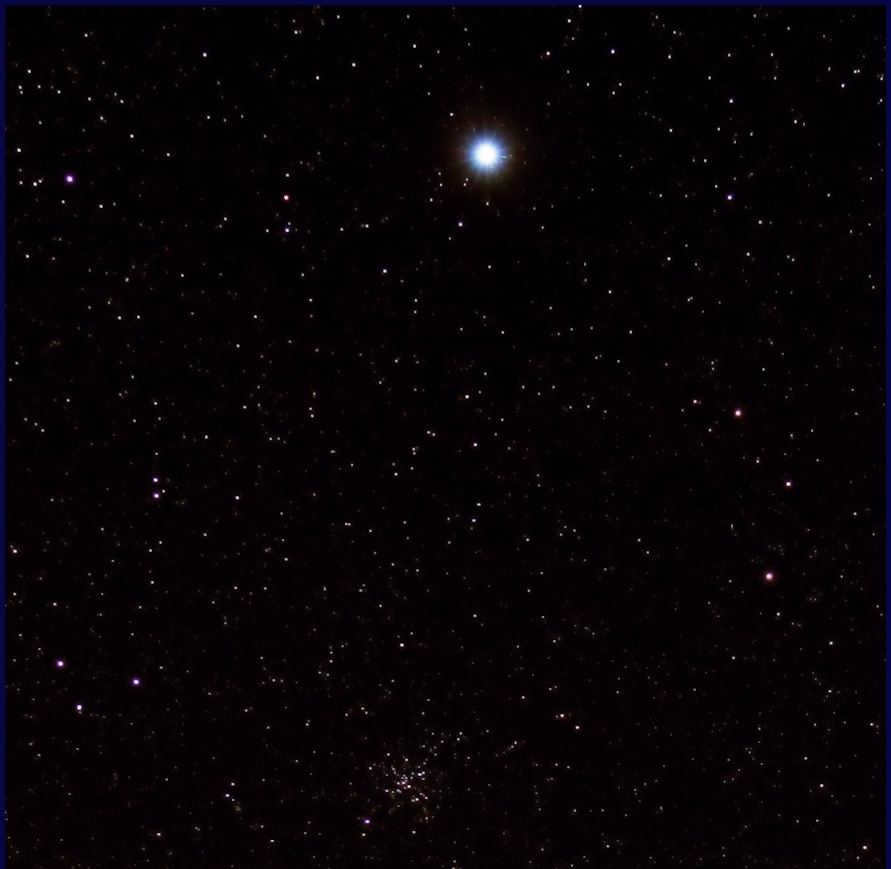
Sirius and the dispersed cluster M41
Sirius, one of the most easily observable objects for amateur astronomers, shines brightly with a stellar magnitude of -1.46. As a result, astrophotographers can capture stunning images of it.
However, its brightness also presents a challenge for photographers, requiring meticulous data processing and careful preparation.
Nevertheless, many astrophotographers have successfully captured the scintillating Sirius, and you can admire the impressive outcome of their efforts in this exquisite photograph taken on January 1, 2013.
The satellite that cannot be seen
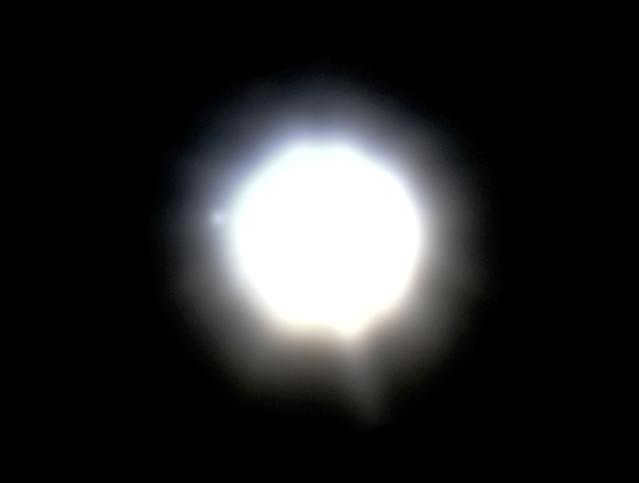
Sirius B can be observed on the left side of the primary star.
Astronomers in the 19th century made an interesting observation regarding Sirius. They noticed that its path, despite appearing straight, experiences periodic oscillations. When represented in the celestial map, the trajectory appears to be a curved wave.
The periodic oscillations of Sirius can be observed even for a brief duration, which is remarkable considering the vast distances that separate us from the stars. Astronomers have hypothesized that these fluctuations are caused by an elusive celestial body that orbits Sirius every 50 years.
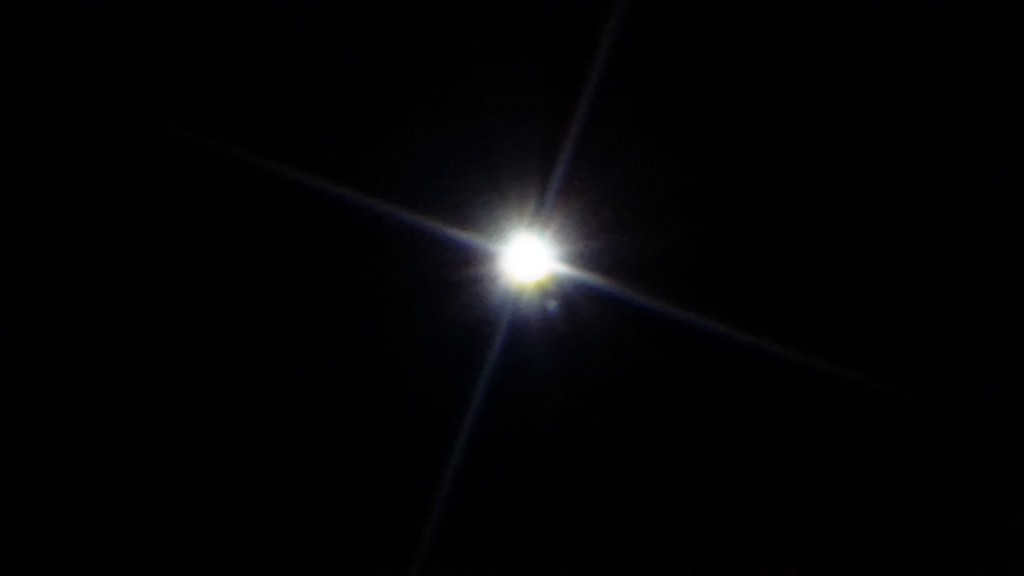
After 18 years of making the daring assumption, a small star has been found near Sirius. This star has a stellar magnitude of 8.4 and is not only the first white dwarf ever discovered, but also the most massive one found to date.

